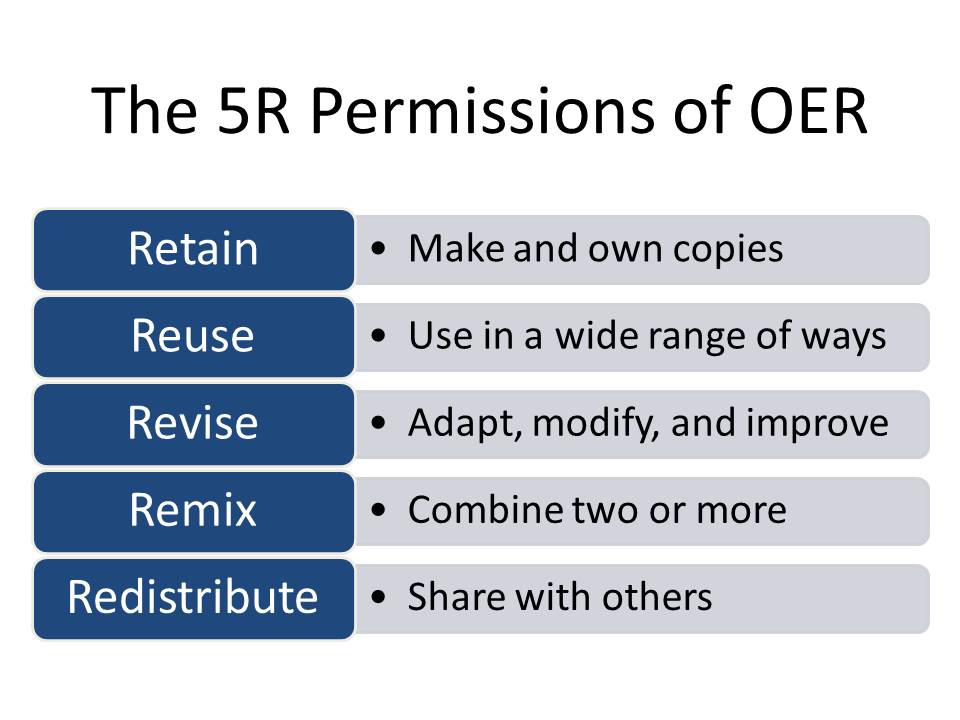There’s an AP story about open textbooks making the rounds in a variety of outlets over the last few days (e.g., ABC News). The story includes some quotes from David Anderson, executive director for higher education at the Association of American Publishers. It boggles my mind that someone whose industry faces an existential threat from open educational resources (OER) still doesn’t know what open means. How can you effectively fight the enemy you fundamentally fail to understand? In describing the industry’s response to OER, the article states:
David Anderson, executive director for higher education at the Association of American Publishers, said the industry is already shifting from print to digital in a change that will bring down student costs.
Oh. My. Gosh. If the threat to publishers was solely about free content – and could consequently be solved by bringing down costs – publishers would be worrying about the internet instead of OER. After all, all of the content on the public internet is free – petabytes and petabytes of information, all there, all free. The amount of free information online dwarfs the amount of information available as OER. If the concern were about “competing against free content,” OER would never even come up in conversation because it’s such a tiny sliver of all the free content available online.
OER are not a threat to publishers simply because they’re free. OER are a threat to publishers because the “open” in OER means free plus permissions. It’s not like this is a secret. “Free plus permissions” is the meaning of open in every context in which the term is used, as I recently explained, yet again, at length. OER are a threat to publishers because, while publishers might be able to drop costs on their materials to the point that the cost of their products approaches free, publishers are structurally incapable of granting 5R permissions in their content and platforms to the general public.
Free isn’t the threat to publishers, open is. Either publishers and the AAP don’t understand that, which is mind-boggling, or they’re so scared by that knowledge that they’re engaging in a systematic misinformation campaign to obscure open from the view of the public and the media by diverting attention to free. Are they that sophisticated?
Anderson goes on to critique OER:
“A big issue for the open source movement has been its sustainability. And that’s one of the reasons you’re seeing a lot of legislation about it because they are looking basically to the taxpayer,” he said.

I hope to hear more of this criticism of OER from publishers and AAP in the future. Why? The US PIRG’s recent report Covering the Cost estimates that each year approximately $3B – that’s $3,000,000,000US – of financial aid dollars are spent by undergraduates on textbooks and other proprietary educational materials. In other words, under the existing commercial textbook model students are simply valves through which taxpayer dollars flow to publishers. I would love the opportunity to get this number in front of more people.
If you want to talk about sustainability, how about this idea. Rather than continuing to give away $3B in taxpayer dollars to commercial publishers year after year, let’s take 5% of this amount and dedicate it to creating and maintaining OER. We’d still be spending these dollars on educational materials, we’d just doing it in a way that actually makes sense. (And we can dedicate the remaining $2.85B to covering tuition costs for more students, dramatically increasing access to higher education and lowering student debt.)
When $3B of public funding is spent in a year on textbooks and other commercial materials, what is the direct return on that investment to the public whose $3B was given to publishers? Nothing. The 1.5% of the population who are college students will have access to a textbook, but that access will likely be short-lived since many students will either rent their books or sell them back at end of term. However, if you spent $150M of that taxpayer money on OER, what would be the direct return to the taxpaying public? Perpetual, irrevocable, free access with 5R permissions to a broad range of educational materials that anyone and everyone can freely copy, localize, use, and share.
So yes, please, let’s talk about who’s going to the taxpayers for their sustainability model. Let’s talk about how $3B is being spent each year to provide 1.5% of the population with fleeting access to read-only educational materials. Then let’s talk about how 5% (or 10%!) of that money, spent wisely, would provide the entire population of the US with permanent, free access to open educational resources that they can all retain, reuse, revise, remix, and redistribute. That sounds far more sustainable to me.

I’m on the fence about whether commercial publishers are in denial at least publicly or clueless. The Titantic took a long time to hit the iceberg and then to sink. Commercial publisher’s market share is so large that it will take a long time for them to go down, even if they continue pursuing their current strategy. Their basic problem is their business model is inconsistent with an OER view of the world. They are an industry with so much overhead to support based on a print model that they have to generate a huge amount of revenue to maintain themselves. I don’t see it continuing forever.
I do concede that the commercial model, with tons of ancillary products most of which are lazy, time-savers are consistent with one direction higher ed might go: that of just-in-time adjunct instructors who convene courses, rather than develop the relationships with students that real learning requires. (I’m not criticizing the myriad of underpaid contingent faculty, just the model that employs the majority of them.) These instructors generally lack the time and support of their employers to make good use of the 5Rs. It will be interesting (in the same way that brain surgeons find a tumor interesting) to see which part of the model breaks first.